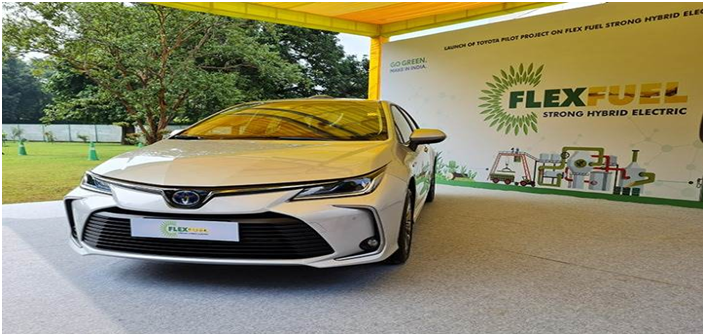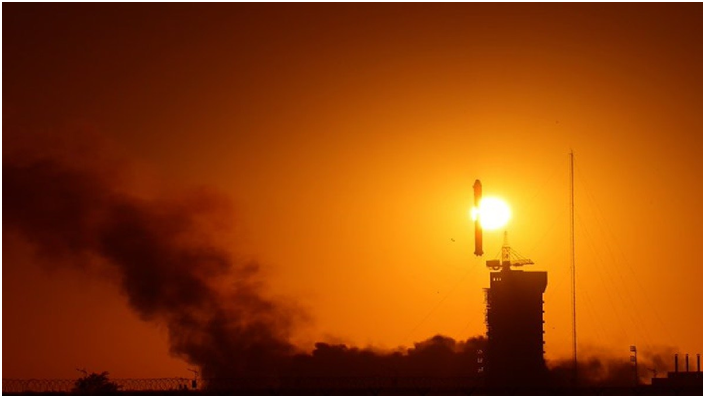Pilot project on Flexi-Fuel Strong Hybrid Electric Vehicles (FFV-SHEV) (GS Paper 3, Environment)

Why in news?
- Recently, the Union Minister for Road Transport and Highways launched Toyota’s first of its kind pilot project on Flexi-Fuel Strong Hybrid Electric Vehicles (FFV-SHEV) in India.
- FFV-SHEV would run on 100% petrol as well as 20 to 100% blended ethanol and electric power.
What is FFV-SHEV?
- An FFVSHEV has a flex-fuel engine and an electric powertrain, thus providing dual benefit of higher ethanol use and greater fuel efficiency, as it can run for a significant time period on its EV mode, wherein the engine is shut off.
- Flex-fuel compatible cars can run on more than one type of fuel and also a mixture. Typically, a blend of petrol and ethanol or methanol is used.
- FFVs provide an opportunity of greater substitution of petrol by ethanol as it is capable of using any of the higher blends of ethanol mix from 20 per cent up to 100 per cent.
Nations opted for FFV-SHEV:
- Flex-fuel vehicles are available in Brazil, the USA and Canada.
- In Brazil, flex fuel-strong hybrid electric vehicle technology has been introduced by Toyota Brazil.
- Ethanol is a major alternate fuel used globally and Brazil has the highest average blending of 48 per cent.
Way Forward:
- The success of this pilot project will create an ecosystem of electric vehicles and make NewIndia, a global leader in the manufacture of these electric vehicles.
- Such technologies are innovative, revolutionary, sustainable, cost-effective, energy-efficient & will completely transform the transportation sector in New India.
Commitment to Reducing Inequality Index (CRII) 2022
(GS Paper 3, Economy)
Why in news?
- Recently, the Commitment to Reducing Inequality Index (CRII) was released.
- Norway leads the CRII followed by Germany and Australia.
What is CRII?
- The Index which is prepared by Oxfam International and Development Finance International (DFI) measures governments policies and actions in three areas proven to have a major impact on reducing inequality.
- The three areas are public services (health, education, and social protection), taxation and workers' rights.
- The 2022 CRII looks at government policies and actions in 161 countries to fight inequality during the first two years of the COVID-19 pandemic.
 2022.png)
Key observations about India:
- India has moved up six places to rank 123 out of 161 countries for reducing inequality but continues to be among the lowest performers in health spending.
- India's overall rank has improved by six points from 129 in 2020 to 123 in 2022. It has moved up 12 places to rank 129 for reducing inequality through progressive spending.
- The country ranks 16 for progressive taxation, up by three.
- Under ranking for minimum wage, India has fallen 73 places due to the counttrybeing reclassified as not having a national minimum wage.
- Under the 'Impact of public spending on reducing inequality indicator', India has moved up 27 places and under 'Impact of tax on reducing inequality indicator', India has moved up 33 places.
- The 2022 CRII report shows India making marginal gains when it comes to reducing inequality during the COVID-19 pandemic.
Health spending by India:
- India features among the lowest performers on health spending again. The index showed that it has dropped a further two places in the rankings, to 157th, the 5th lowest in the world.
- India even made small cuts on health spending between 2019 and 2021 at a time of unprecedented health need and crisis.
- Given the wide criticism of the government's response to COVID-19 and the great need for healthcare improvements, it is disappointing to see that things are still moving in the wrong direction.
- India's health spending is 3.64 per cent of total spending. This is the lowest out of all BRICS and neighbouring countries, the report said.
- While China and Russia are spending 10 per cent, Brazil is at 7.7 per cent and South Africa is highest at 12.9 per cent. Even in neighbouring countries, Pakistan is at 4.3 per cent, Bangladesh at 5.19 per cent, Sri Lanka at 5.88 per cent and Nepal at 7.8 per cent.
National minimum wage:
- Twelve countries in the Index have no national minimum wage with India joining this list since 2020.
- India has been reclassified as not having a minimum wage, given that a large number of workers, like domestic workers in many states, are not covered by minimum wages.
Conclusion:
- Despite huge pressure on government finances, 143 of 161 countries froze the tax rates on their richest citizens, and 11 countries even lowered them.
- The index shows that most governments have completely failed to take the steps needed to counter the inequality explosion created by COVID-19.
- They ripped away public services when people needed them most, and let billionaires and big corporations off the hook as they reap profits at record number.
Ancient Mars was hit by climate change
(GS Paper 3, Science and Tech)
Context:
- As the Perseverance rover continues to scoop samples from the surface of the Mars, scientists have now found that ancient Mars may have had an environment that could have supported an underground world or microscopic organisms, but their presence may not have been that good for the planet.
- French scientists proposed that these ancient microbes could have triggered an ice age on the planet altering the atmosphere and extinguishing themselves.
- This could be the first evidence of sign of climate change hitting the planet and making it barren for centuries to come.

Favorable environment for microbes:
- The study states that Mars crust may have provided a favourable environment for microbial life and the porous brine-saturated regolith would have created a physical space sheltered from ultraviolet and cosmic radiation.
- The below-ground temperature and diffusion of a dense, reduced atmosphere may have supported simple microbial organisms that consumed H2 and CO2 as energy and carbon sources and produced methane as a waste.
- At the time Mars was thought to be filled with water and much more hospitable than today. The study points out that these hydrogen-consuming microbes produced methane and flourished just beneath the surface with several inches of dirt.
- However, early Mars presumably moist, warm climate, would have been jeopardized by so much hydrogen sucked out of the thin, carbon dioxide-rich atmosphere.
- With temperatures falling any organisms at or near the surface likely would have buried deeper in an attempt to survive.
Impact:
- They find that subsurface habitability was very likely and limited mainly by the extent of surface ice coverage.
- However, the predicted atmospheric composition shift caused by methanogenesis would have triggered a global cooling event, ending potential early warm conditions, compromising surface habitability, and forcing the biosphere deep into the Martian crust.
What’s next?
- They identified three locations where traces of these ancient microbes would have most likely survived closer to the surface.
- These locations include Jezero Crater, where NASA's Perseverance rover currently hunts for rock samples that could harbor traces of this ancient life, and two low-lying plains: Hellas Planitia at mid-latitudes on the southern hemisphere, and IsidisPlanitia just north of the Martian equator.
- Next, the researchers would like to find out whether these ancient microbes could still live anywhere inside Mars' crust.
China launches Kuafu-1 satellite to unravel secrets of the Sun
(GS Paper 3, Science and Tech)
Why in news?
- After successfully integrating its under-construction Space Station and approving the next phase of its lunar missions, China has launched a new observatory that will look into the Sun.
- The Advanced Space-based Solar Observatory (ASO-S) was launched onboard a Long March-2D rocke from the Jiuquan Satellite Launch Center in northwest China.

Key Highlights:
- Nicknamed Kuafu-1, after a giant in Chinese mythology who chased the sun, the observatory has been placed in an orbit about 720 kilometers above the planet, higher than the orbit of the International Space Station.
- With the satellite now placed into orbit, a six-month-long commissioning phase will begin, after which science operations will commence.
- The spacecraft will study the causality between the solar magnetic field and two major eruptive phenomena: solar flares and coronal mass ejections.
Instruments onboard:
- Kuafu-1 has been launched with three major instruments, which include the Lyman-alpha Solar Telescope (LST), the Hard X-ray Imager (HXI), and the Full-disk Vector MagnetoGraph (FMG).
- The scientific objective for the mission has been described as 1M2B, where M refers to the solar magnetic field and two Bs are for two violent bursts, the solar flares and coronal mass ejections (CMEs).
- The spacecraft will work for 96 per cent of the year, and since it is placed outside the planet, it will not be affected by Earth's atmosphere.
- ASO-S is capable of probing the Sun 24 hours daily for most of the year. Its longest daily time-out is no more than 18 minutes when briefly running through the shadow of Earth each day from May to August.
Significance:
- Designed to remain in service for four years, the mission will beam back about 500 gigabytes of data every day. China's new mission will reveal the secrets of the Sun and reveal new characteristics that propel solar flares and coronal mass ejections.
- Astronomers have long been trying to better understand these phenomena, which affect space weather and their understanding is critical to saving assets in space like the International Space Station and astronauts.
Similar missions by other nations:
- Kuafu is the fourth big mission exploring the Sun after Nasa Parker Solar Probe, which has been getting closer to the Sun alongside European Space Agency's Solar Orbiter and China's own Xihe probe, which was launched in 2021.
- India is also planning to launch a mission dedicated to the Sun, the Aditya L-1 mission will launch next year.



 2022.png)

